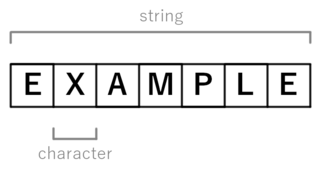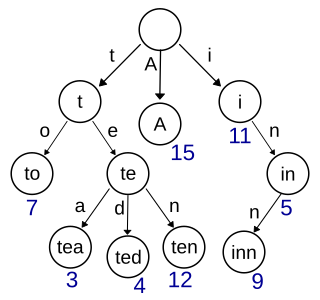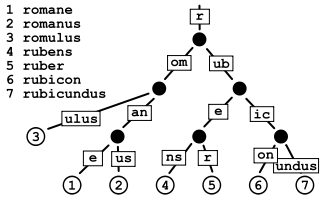Related Research Articles

A hash function is any function that can be used to map data of arbitrary size to fixed-size values, though there are some hash functions that support variable-length output. The values returned by a hash function are called hash values, hash codes, hash digests, digests, or simply hashes. The values are usually used to index a fixed-size table called a hash table. Use of a hash function to index a hash table is called hashing or scatter-storage addressing.

In computer science and information theory, a Huffman code is a particular type of optimal prefix code that is commonly used for lossless data compression. The process of finding or using such a code is Huffman coding, an algorithm developed by David A. Huffman while he was a Sc.D. student at MIT, and published in the 1952 paper "A Method for the Construction of Minimum-Redundancy Codes".

In computer programming, a string is traditionally a sequence of characters, either as a literal constant or as some kind of variable. The latter may allow its elements to be mutated and the length changed, or it may be fixed. A string is generally considered as a data type and is often implemented as an array data structure of bytes that stores a sequence of elements, typically characters, using some character encoding. String may also denote more general arrays or other sequence data types and structures.
A string-searching algorithm, sometimes called string-matching algorithm, is an algorithm that searches a body of text for portions that match by pattern.

In computer science, a trie, also known as a digital tree or prefix tree, is a specialized search tree data structure used to store and retrieve strings from a dictionary or set. Unlike a binary search tree, nodes in a trie do not store their associated key. Instead, each node's position within the trie determines its associated key, with the connections between nodes defined by individual characters rather than the entire key.
Metaphone is a phonetic algorithm, published by Lawrence Philips in 1990, for indexing words by their English pronunciation. It fundamentally improves on the Soundex algorithm by using information about variations and inconsistencies in English spelling and pronunciation to produce a more accurate encoding, which does a better job of matching words and names which sound similar. As with Soundex, similar-sounding words should share the same keys. Metaphone is available as a built-in operator in a number of systems.
The Burrows–Wheeler transform rearranges a character string into runs of similar characters. This is useful for compression, since it tends to be easy to compress a string that has runs of repeated characters by techniques such as move-to-front transform and run-length encoding. More importantly, the transformation is reversible, without needing to store any additional data except the position of the first original character. The BWT is thus a "free" method of improving the efficiency of text compression algorithms, costing only some extra computation. The Burrows–Wheeler transform is an algorithm used to prepare data for use with data compression techniques such as bzip2. It was invented by Michael Burrows and David Wheeler in 1994 while Burrows was working at DEC Systems Research Center in Palo Alto, California. It is based on a previously unpublished transformation discovered by Wheeler in 1983. The algorithm can be implemented efficiently using a suffix array thus reaching linear time complexity.
Lempel–Ziv–Welch (LZW) is a universal lossless data compression algorithm created by Abraham Lempel, Jacob Ziv, and Terry Welch. It was published by Welch in 1984 as an improved implementation of the LZ78 algorithm published by Lempel and Ziv in 1978. The algorithm is simple to implement and has the potential for very high throughput in hardware implementations. It is the algorithm of the Unix file compression utility compress and is used in the GIF image format.
Punycode is a representation of Unicode with the limited ASCII character subset used for Internet hostnames. Using Punycode, host names containing Unicode characters are transcoded to a subset of ASCII consisting of letters, digits, and hyphens, which is called the letter–digit–hyphen (LDH) subset. For example, the German München is encoded as Mnchen-3ya.

Alphabetical order is a system whereby character strings are placed in order based on the position of the characters in the conventional ordering of an alphabet. It is one of the methods of collation. In mathematics, a lexicographical order is the generalization of the alphabetical order to other data types, such as sequences of numbers or other ordered mathematical objects.

In information theory, linguistics, and computer science, the Levenshtein distance is a string metric for measuring the difference between two sequences. The Levenshtein distance between two words is the minimum number of single-character edits required to change one word into the other. It is named after Soviet mathematician Vladimir Levenshtein, who defined the metric in 1965.
In computer science, the Rabin–Karp algorithm or Karp–Rabin algorithm is a string-searching algorithm created by Richard M. Karp and Michael O. Rabin that uses hashing to find an exact match of a pattern string in a text. It uses a rolling hash to quickly filter out positions of the text that cannot match the pattern, and then checks for a match at the remaining positions. Generalizations of the same idea can be used to find more than one match of a single pattern, or to find matches for more than one pattern.
In computer science, the Boyer–Moore string-search algorithm is an efficient string-searching algorithm that is the standard benchmark for practical string-search literature. It was developed by Robert S. Boyer and J Strother Moore in 1977. The original paper contained static tables for computing the pattern shifts without an explanation of how to produce them. The algorithm for producing the tables was published in a follow-on paper; this paper contained errors which were later corrected by Wojciech Rytter in 1980.
Soundex is a phonetic algorithm for indexing names by sound, as pronounced in English. The goal is for homophones to be encoded to the same representation so that they can be matched despite minor differences in spelling. The algorithm mainly encodes consonants; a vowel will not be encoded unless it is the first letter. Soundex is the most widely known of all phonetic algorithms Improvements to Soundex are the basis for many modern phonetic algorithms.

In computer science, a radix tree is a data structure that represents a space-optimized trie in which each node that is the only child is merged with its parent. The result is that the number of children of every internal node is at most the radix r of the radix tree, where r = 2x for some integer x ≥ 1. Unlike regular trees, edges can be labeled with sequences of elements as well as single elements. This makes radix trees much more efficient for small sets and for sets of strings that share long prefixes.
Algorithmic information theory (AIT) is a branch of theoretical computer science that concerns itself with the relationship between computation and information of computably generated objects, such as strings or any other data structure. In other words, it is shown within algorithmic information theory that computational incompressibility "mimics" the relations or inequalities found in information theory. According to Gregory Chaitin, it is "the result of putting Shannon's information theory and Turing's computability theory into a cocktail shaker and shaking vigorously."
In computer science and statistics, the Jaro–Winkler similarity is a string metric measuring an edit distance between two sequences. It is a variant of the Jaro distance metric proposed in 1990 by William E. Winkler.

Meteg is a punctuation mark used in Biblical Hebrew for stress marking. It is a vertical bar placed under the affected syllable.
Tamil All Character Encoding (TACE16) is a scheme for encoding the Tamil script in the Private Use Area of Unicode, implementing a syllabary-based character model differing from the modified-ISCII model used by Unicode's existing Tamil implementation.
Cologne phonetics is a phonetic algorithm which assigns to words a sequence of digits, the phonetic code. The aim of this procedure is that identical sounding words have the same code assigned to them. The algorithm can be used to perform a similarity search between words. For example, it is possible in a name list to find entries like "Meier" under different spellings such as "Maier", "Mayer", or "Mayr". The Cologne phonetics is related to the well known Soundex phonetic algorithm but is optimized to match the German language. The algorithm was published in 1969 by Hans Joachim Postel.
References
- ↑ Moore, G B.; Kuhns, J L.; Treffzs, J L.; Montgomery, C A. (Feb 1, 1977). Accessing Individual Records from Personal Data Files Using Nonunique Identifiers. US National Institute of Standards and Technology. p. 17. NIST SP - 500-2.